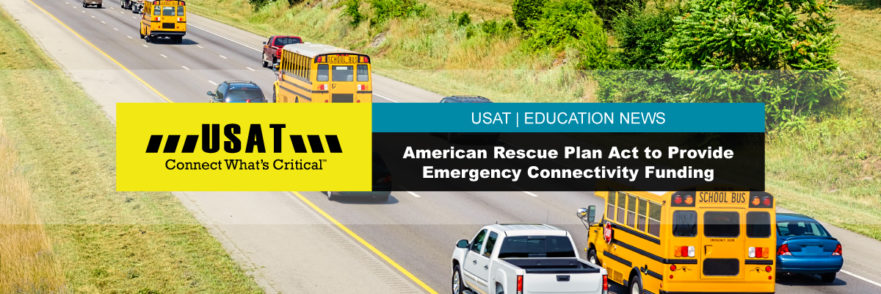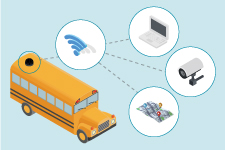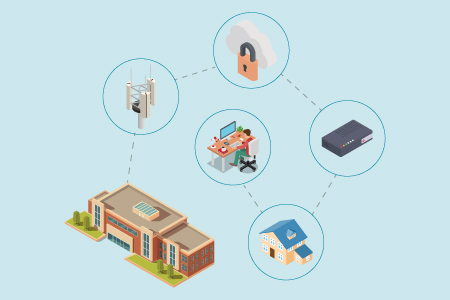Emergency Connectivity Fund provides money to school districts for E-Rate routers supporting Wi-Fi on buses
“Is bus Wi-Fi covered by E-Rate” is just one of many questions that school districts are asking in response to the earmarking of $7.1 billion for the Emergency Connectivity Fund (ECF), part of the American Rescue Plan Act (ARP) for coronavirus relief. The ECF provides “funding for schools and libraries for the purchase, during the coronavirus (COVID- 19) pandemic, of connected devices and broadband connections for use by students, school staff, and library patrons.” More specifically, this funding has been set aside for remote teaching and learning at locations other than schools and libraries.
The FCC has elected to distribute the fund through a process similar to the E-Rate application system.
Who is eligible?
In all cases, Internet access obtained through this program must be used primarily for facilitating learning activities, such as through a school’s remote or hybrid learning plan.
- School buses and bookmobiles
- Schools and libraries NOT participating in the E-Rate program
- Nontraditional institutions that facilitate education, including community centers and churches*
- Credentialed students, school staff, and library patrons**
*Nontraditional entities and requests will need to work with school districts to request services. **For those who otherwise did not or do not have Internet access (subject to certification for school applicants.)
What is eligible?
ECF funds can only be applied to certain categories of hardware and services. For example, ECF funds may be used to pay for or reimburse purchases of:
- Internet modems (Funding cap TBD)
- Internet routers (Funding cap TBD)
- Wi-Fi hotspots ($250 reimbursement cap)
- Laptops, tablets, and Chromebooks ($400 reimbursement cap)
- MC400-5G Modem
ECF funds may also be used for obtaining and maintaining these services (in most cases):
- Wireless Internet (including mobile, satellite, microwave, and fixed wireless)
- DSL Internet
- Cable Internet
- Leased lit fiber Internet
NOTE — Desktops and cell phones are not eligible for reimbursement under the current ECF requirements.
How do I apply?
A revised E-Rate application process for this special round of funding will be used to lower the barrier for obtaining ECF funds. As such, eligible institutions will be able to apply online using the E-Rate EPC Portal. All applicants should note that part of the revised application process stipulates: There will be no FCC-specific competitive bidding mandates, meaning applicants will not be required to file an FCC Form 470. However, applicants will be required to follow all applicable local, state, and Tribal procurement requirements.
Filing window — The initial filing window will be open for 45 days and is estimated to begin in early June 2021. For schools and libraries seeking reimbursement on new Cradlepoint purchases made between July 1, 2021, and June 20, 2022, applications are to be submitted using the existing E-Rate online portal. Additional prospective or retroactive filing windows may be opened if significant funds are still available.
Emergency Connectivity Fund FAQs
Who is eligible to receive funds through the Emergency Connectivity Fund Program?
Students, school staff, and library patrons (with credentials) — Specifically named in the order are students, school staff, and library patrons who would otherwise lack access to a device sufficient to enable them to engage in remote learning. Applicants may purchase one device per student; this applies to every student, regardless of their NSLP eligibility. The order does not limit support to just “teachers”; rather, it incorporates a broader population by identifying “school staff” as eligible for support.
Locations — Schools, libraries, and consortia of eligible schools and libraries that are eligible for support under the FCC’s E-Rate program are eligible to request and receive support through the Emergency Connectivity Fund (ECF) Program. In addition, the order clarifies that Tribal libraries, which are eligible for support under the Library Services and Technology Act, are also eligible for the ECF.
E-Rate participation — Schools and libraries eligible for the ECF Program do not need to be current E-Rate participants. Eligible entities that have not applied for E-Rate support should be prepared to demonstrate eligibility as a school or library under the program rules during USAC’s application review.
What equipment and services are covered by the Emergency Connectivity Fund Program?
The ECF will provide support for broadband Internet connectivity to off-campus locations, such as student or library patron homes. In addition, funds will be available for hotspot, router, and modem hardware, as well as “connected devices” like laptops or tablets.
Broadband equipment — Modems, routers, and Wi-Fi hotspots will qualify for reimbursement. A funding cap has not been placed for modems and routers, but Wi-Fi hotspots will be capped at $250.
Broadband services — There are no minimum standards for network connections. One Wi-Fi hot spot is allowed per user, and, for fixed Internet connections, only one service connection is allowed per location. There are no current price caps for broadband services.
Limited support for Private Cellular Networks — Where applicants can prove there is no commercially available internet access, applicants may seek funding for the construction of such networks.
What are the reasonable support amounts for E-Rate-eligible equipment?
Hotspots — $250 is the “maximum reasonable cost for a Wi-Fi hotspot provided by a school or library to a student, school staff member, or library patron.” An applicant can spend more but will only be reimbursed up to $250 per hotspot. This maximum allowable cost is for the equipment itself, not the service. The cost of the service is not subject to a predefined price cap.
Laptops — $400 is the maximum reimbursement amount for laptops, tablets, etc. An applicant can spend more but will only reimburse up to $400 per device. An applicant may request a waiver of the $400 limit for users with disabilities, if necessary.
Other items — Items such as modems and routers are not subject to a specific price cap, but USAC will review requests and identify those that are substantially higher than normal.
When will USAC open the first window for E-Rate funding?
Initial filing window (“new purchases”) — There will be an initial 45-day filing window for schools and libraries to seek reimbursement for eligible purchases made between July 1, 2021, and June 30, 2022. This is the so-called “prospective” reimbursement filing window.
Subsequent filing windows — If significant funds remain available, the commission may decide to open another prospective filing window; alternatively, the commission may open a “retroactive” filing window for eligible purchases made between March 1, 2020, and June 30, 2021.
How can schools or libraries apply?
Existing E-Rate forms will be used for paperwork — The ECF program will be administered by USAC, and, where possible, will use forms that exist within the online E-rate portal (EPC) The FCC has indicated the E-Rate forms that will be used are the Form 471, Form 472 (BEAR), and Form 474 (SPI). Form 471 will be used as the vehicle for applying. Form 472 (BEAR) and Form 474 (SPI) will be used to seek reimbursement.
Invoices — Detailed invoices will be required at the time payment paperwork is submitted. Applicants that seek payment from the ECF prior to paying their service provider(s) must also provide verification of payment to the service provider(s) within 30 days of receipt of funds.
SAM registration — All applicants must register in System for Award Management (SAM.gov). SAM is a web-based application that collects, validates, stores, and disseminates business information about the federal government’s partners in support of federal awards, grants, and electronic payment processes. It can take up to 20 days for a SAM registration to become active and an additional 24 hours before that registration information is available in other government systems.
Decisions tied to close of filing window — USAC will wait until the filing window is closed and all applications are tallied to begin issuing funding commitments. The goal is for USAC to process 50% of applications within 60 days after the close of the filing window.
Discount rate determines who receives funding — Should demand exceed available funds, applications will be prioritized and processed based on the Category 1 E-Rate discount rate associated with a school or library. Rural applicants will receive a 5% “bump” to the discount rate used to calculate the priority of their applications. For example, rural schools and libraries who qualify for a 90% discount rate in the E-Rate program will use a 95% discount and will receive top priority over their urban counterparts who also qualify for a 90% E-Rate discount. If there are insufficient funds available to fund an entire discount band, priority will be given to applicants with the highest percentage of low-income students.
No extra FCC bidding — There will be no FCC-specific competitive bidding mandates (e.g., the FCC Form 470); however, applicants will certify compliance with applicable local, state, and Tribal procurement requirements.
How will schools and libraries be reimbursed?
Other questions about E-Rate
How do CIPA laws impact ECF? — ECF recipients will be required to comply with CIPA requirements in a similar way to E-Rate funding recipients. The CIPA requirements will apply for the use of computers (laptops, tablets, etc.) that are owned by the applicant (school or library), if the applicant receives funding for Internet service through ECF or E-Rate.
Compliance with CIPA is not required if 1) the devices are owned by the school or library applicant, but the applicant is not receiving Internet service funding from either ECF or E-rate, or 2) the devices are owned by a third party (the student or library patron).
The CIPA certifications for the ECF program will be included on the FCC Form 471 that applicants submit for ECF funding requests (no additional Form 486 CIPA certification will be required).
What are the documentation requirements? — Applicants will be required to follow the standard 10-year documentation requirement, similar to the scope of the E-Rate program.
Is there an appeal deadline? — Applicant appeals must be submitted within 30 days, rather than the E-Rate program’s customary 60-day deadline.
Does my organization still qualify if we previously received ESSER or CARES support? — The FCC will not provide support for eligible equipment and services that have already been reimbursed through other federal pandemic relief programs (e.g., CARES Act, Emergency Broadband Benefit Program, or other provisions of the American Rescue Plan); state programs specifically targeted to providing funding for eligible equipment and services; or other external sources of funding or gifts specifically targeted to providing funding for eligible equipment and services.
Learn more about using E-Rate funding for school bus Wi-Fi solutions by contacting us.
Contact USAT
If you need help procuring cellular devices for in-home, in-school, or in-vehicle use, please don't hesitate to contact us via one of the three methods below.
For More Information:
- Give Us a Call: (919) 942-4214
- Send Us an Email: info@usatcorp.com
- Request a Free Consultation: Click Here
Share this Post















